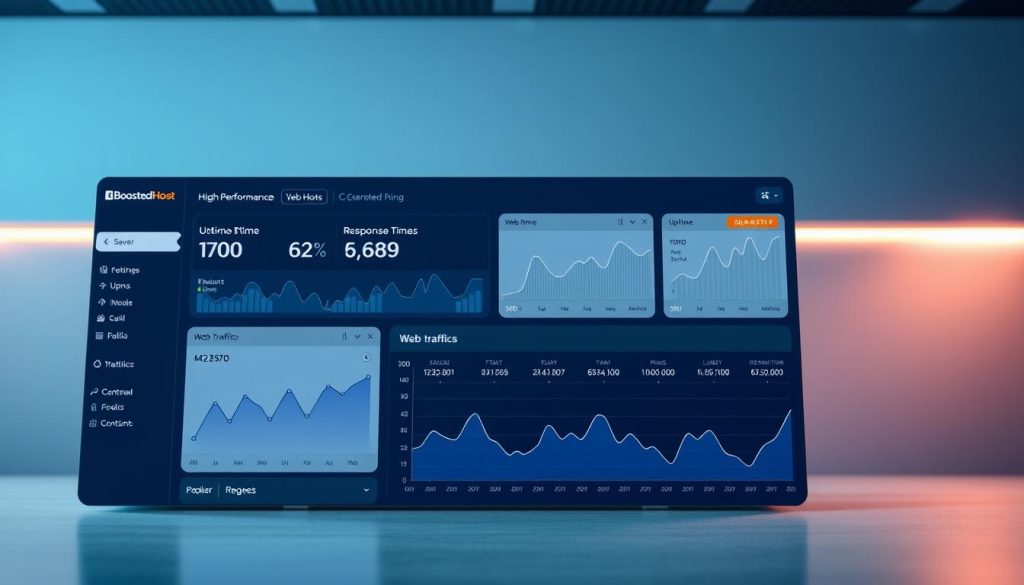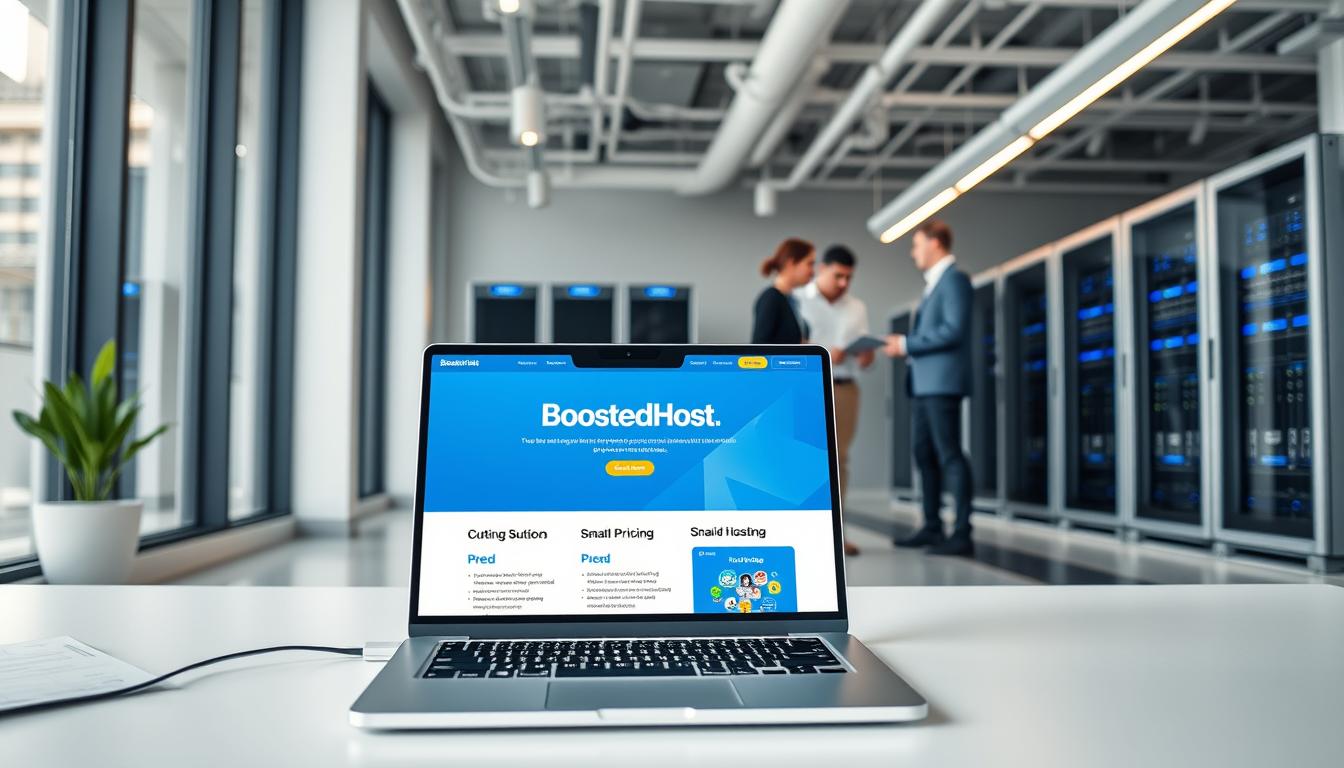We know what it feels like when a page won’t load and a sale slips away. We’ve lost nights fixing slow sites and learned that the right hosting makes or breaks momentum for a small business.
In this comparison we test performance, uptime, pricing, and support across leading web hosting options. Our aim is simple: help you pick a web host that protects revenue and speeds growth in 2025.
Expect clear findings on speed, reliability, and included features — from server response times to daily backups, CDN, and developer support for PHP, Node.js, Python, and WooCommerce.
We call out industry traps like teaser pricing and renewal jumps. Then we show where transparent pricing and 24/7 expert support create real value for your website and business.
Key Takeaways
- Speed and uptime drive conversions—pick a hosting service with sub-200ms TTFB and 99.99% uptime.
- Transparent pricing avoids surprise renewals and helps budgeting across the year.
- Built-in features—SSL, CDN, daily backups—save time and reduce risk for your site.
- 24/7 expert support shortens downtime and improves the hosting experience.
- Developer and ecommerce readiness means you can scale without switching company or platform.
At a Glance: Which web host delivers the best mix of speed, uptime, features, and value?
Here’s a quick snapshot showing which host balances real speed, uptime, and price for US sites. We focus on measurable results: sub-200ms global TTFB, near 99.99% uptime, and what each plan actually includes.
Headline metrics: One provider hits sub-200ms TTFB and 99.99% uptime on shared and managed tiers. Many competitors advertise low intro pricing but raise renewal rates and charge for CDN or backups.

What’s included at no extra cost: SSL, daily backups, malware protection, global CDN, and email in a single bundled offering. That reduces total cost of ownership versus plans that add fees for basics.
- Use case fit: personal website, small business, or agency—plans scale without nickel‑and‑diming.
- Global reach: multiple data centers cut latency for US and international visitors.
- Support & AI: 24/7 expert help and an AI site builder (Orbit) speed setup and fixes.
For a practical starting point, see our recommended web hosting plans and match features to your budget before you commit.
BoostedHost vs home.pl: How we tested and what matters most in 2025
We ran hands‑on tests to measure real speed, uptime, pricing transparency, and support quality in 2025.
Our process focused on metrics that affect real websites. We built WordPress test sites, applied caching, and measured global TTFB. We also toggled CDN and ran stress tests on static and dynamic pages.
Key criteria:
- Speed: global TTFB, HTTP/3, and caching impact on page load.
- Reliability: continuous uptime monitoring against a 99.99% target.
- Transparency: intro vs renewal pricing, mandatory add‑ons, and true cost per plan.
- Included features: SSL, daily backups, malware protection, CDN, and email.
- AI & support: Orbit timing from prompt to published site and 24/7 support response metrics.

“Real tests show whether a hosting service protects conversions and scales with your site.”
| Test area | Method | What we measured |
|---|---|---|
| Speed | WordPress builds, synthetic and RUM | Global TTFB, full load time, HTTP/3 gains |
| Uptime | Continuous monitoring | Downtime minutes, restore workflows |
| Pricing | Plan audit | Intro vs renewal, add‑on costs, true monthly price |
| Support & AI | Live chat, tickets, Orbit publish timing | First response, resolution time, published site quality |
We tracked server stack details—LiteSpeed vs standard web servers—and tested developer tools like SSH, Git, and staging. We kept tests fair and noted where regional bundles or strengths may sway choice for certain buyers.
Speed and performance: LiteSpeed edge, sub-200ms global TTFB, and real‑world load times
Speed wins: real‑world server tests reveal which stacks deliver faster pages worldwide. We focus on what users feel — first byte, first contentful paint, and checkout speed.
LiteSpeed servers paired with optimized caching and a built‑in CDN hit global TTFB under 200ms in our trials. That combination reduces round trips and keeps dynamic pages fast under load.
Global TTFB under 200ms with LiteSpeed servers and optimized caching
LiteSpeed’s event‑driven architecture, HTTP/3 support, and LSCache deliver consistent server response times. OPcache and persistent object caching further cut PHP overhead for WordPress sites.
Static and dynamic content delivery with a built‑in CDN for faster websites
Edge caching speeds static assets. Object caching and LSCache rules speed dynamic pages. A unified CDN removes third‑party hops and improves image and script routing.
Managed WordPress performance tuning for high‑traffic sites
Managed tuning—queue control, resource isolation on shared hosting, and server‑level rules—lets high‑traffic sites keep UX and conversions intact without late migrations.
“Quicker first paints and smoother checkouts directly lift conversions and SEO.”
| Feature | Impact | Result |
|---|---|---|
| LiteSpeed + HTTP/3 | Lower latency, more concurrent connections | Sub‑200ms global TTFB |
| Built‑in CDN | Edge delivery, fewer external calls | Faster asset load, better global reach |
| WP tuning (OPcache, LSCache) | Reduced PHP work, smarter caching | Stable performance under traffic |
Uptime and reliability you can bank on
Downtime steals sales; reliable uptime and fast recovery keep your business running. We measure uptime in minutes lost per month and tie that to real revenue risk for your web presence.
Consistency near 99.99% and why that protects your business
99.99% uptime sounds like a number. It becomes meaningful when you see minutes of downtime mapped to lost orders and trust.
Providers that publish credits may still leave you waiting. We prioritize tracked uptime, rapid restores, and platform isolation so one noisy neighbor doesn’t take your site offline.
Daily backups and rapid restore pathways for true resilience
Daily backups with one‑click restores cut mean time to recovery after plugin errors, hacks, or bad updates. That keeps recovery windows short.
- Layered protection — malware scanning, WAF, and proactive monitoring — reduces incidents before they affect uptime.
- Staged updates and restore testing make sure backups work when you need them.
- 24/7 expert support resolves most issues in minutes, not days.
For small business and ecommerce, steady availability beats theoretical peaks. Pick a hosting plan that matches your SLA needs and makes reliability routine — so your company can focus on growth, not firefighting.
“Reliability is less about perfect uptime and more about fast detection, recovery, and clear accountability.”
Pricing and transparency: Plans, renewals, and real cost per month
Real cost per month depends on what a plan actually includes, not the flashy intro price.
Many providers advertise low entry pricing that jumps at renewal. That makes budgeting hard for a website or company.
We break down true monthly costs — intro rate, renewal, and common add‑ons like CDN, backups, and email. This shows you the actual per‑month spend over a year.
Intro pricing versus renewal rates on shared hosting plans
Teaser rates often assume multi‑year commitments. Monthly billing exists, but it raises the per‑month cost.
We compare shared hosting plans by initial price, renewal, and bundled services. That keeps surprises off your bill.
No hidden fees: SSL, backups, and CDN included versus add‑ons
Some companies charge for SSL, daily backups, or a CDN. That inflates true pricing fast.
An inclusive model with SSL, malware protection, daily backups, CDN, and email lowers year‑one and renewal costs.
Value for individuals, small businesses, and agencies
- Starter plan: low storage and one domain — good for personal sites.
- Business plan: more storage, email quotas, and better support for ecommerce.
- Agency plan: higher storage, multiple accounts, and staging for many sites.
| Plan tier | Typical monthly (intro) | Renewal per month |
|---|---|---|
| Starter (personal) | $3.99 | $6.99 |
| Business (small biz) | $9.99 | $14.99 |
| Agency / Managed WP | $29.99 | $39.99 |
“Predictable billing beats teaser rates — especially when uptime, support, and backups matter.”
Included features that matter for modern hosting
We look for bundled tools that remove admin work and protect site performance. A clear feature set keeps teams focused on growth, not firefighting.
Free SSL on every site for trust and SEO
SSL should be standard. It protects data, removes browser warnings, and helps search rankings. Free certificates avoid surprise fees when you add domains.
Automated daily backups with one‑click restores
Daily backups are the safety net. One‑click restores let you recover from bad updates or plugin conflicts in seconds. That lowers downtime and recovery effort.
Malware protection, WAF, and proactive monitoring
Security must be proactive. Malware scanning and WAF rules catch attacks early. Continuous monitoring alerts teams before issues escalate.
Global CDN and email hosting to round out your stack
A built‑in CDN speeds assets worldwide without extra setup. Integrated email keeps communication and domain management under one account. Clear storage tiers let media scale with your site.
“Bundled essentials — SSL, backups, security, CDN, and email — reduce cost and complexity for websites.”
| Included feature | Bundled at no extra cost | Common competitor add‑on |
|---|---|---|
| SSL | Yes | Sometimes paid |
| Daily backups + one‑click restore | Yes | Often paid or limited |
| Malware/WAF | Yes | Reactive or paid |
| Global CDN | Yes | Paid upgrade |
| Email hosting & storage | Included | Separate provider |
AI website builder face‑off: Orbit vs typical site builders
Orbit turns a brief prompt into a polished site and gets you online faster than most drag‑and‑drop builders. It produces clean HTML, structured metadata, and a sitemap so your new website is SEO‑ready at launch.
Launch a professional site in under five minutes with Orbit
We can generate a full site from a prompt in minutes. Orbit outputs lean code that pairs with LiteSpeed, a global CDN, and managed WordPress for instant performance gains.
That means: faster first byte, lower CLS, and fewer plugins to manage. The result is a site that ranks sooner and handles traffic better.
Where simpler builders fall short on speed, SEO, and scalability
Many entry‑level builders prioritize ease but ship bloated scripts and limited exportability. That creates bottlenecks on shared hosting without tuned caching or CDN.
- Orbit avoids heavy themes by producing minimal, semantic markup.
- Managed WordPress plus Orbit removes busywork — caching, image optimization, and updates are handled for you.
- 24/7 support backs the builder and the platform for end‑to‑end troubleshooting.
“For fast launches that scale, choose a builder tied to a performance stack — not a flashy, locked‑in editor.”
| Feature | Orbit | Typical builder |
|---|---|---|
| Launch time | Minutes | Hours–Days |
| SEO foundations | Clean HTML, metadata, sitemap | Often plugin‑dependent |
| Scalability | WordPress hosting + CDN | Theme limits, export issues |
Developer stack and ecommerce readiness
We build for teams and stores that must scale without surprises. Pick a hosting plan that supports modern languages and deploy tools out of the box.
PHP, Node.js, and Python support for modern apps and workflows
Good developer tooling matters. Look for PHP version control, Node.js and Python runtimes, SSH, Git, and staging environments.
These features reduce friction during CI/CD and let teams ship updates safely.
WooCommerce‑ready WordPress hosting for stores that scale
WooCommerce optimizations include database tuning, cache rules for cart pages, and CDN strategies that keep checkouts fast.
We recommend choosing plans based on traffic, product count, and concurrency. That avoids emergency migrations.
- Plan upgrades: shared hosting → virtual private or cloud hosting when traffic spikes.
- Storage planning: separate media, product assets, and logs so growth stays predictable.
- Server isolation and monitoring protect uptime during promotions and launches.
| Need | Recommended move | Why |
|---|---|---|
| Small store | Managed wordpress hosting | Fast carts, built‑in cache |
| Growing catalogue | Higher storage plan | Media & backups scale safely |
| Custom apps | Virtual private / cloud hosting | Dedicated resources and control |
“Developer‑friendly hosting and clear upgrade paths keep sites fast and reduce churn.”
Global infrastructure: Data centers and CDN coverage for US audiences
Global edge choices shape real user latency—where you place servers matters as much as the code you ship.
We operate multiple data centers across Switzerland, the USA, Europe, and Asia, paired with a global CDN to cut latency for US‑focused and international traffic.
Choose region to match your audience
Selecting a US or nearby region reduces round‑trip time for American visitors. The CDN then accelerates static assets everywhere.
Compliance, resilience, and routing diversity
Regional placement helps with data residency and compliance when your company requires local storage. Multi‑region deployments and CDN caching also reduce single‑region risk during seasonal spikes.
Plan selection by geography
Pick plans that map to your traffic. A US‑optimized plan keeps costs low while multi‑region options suit brands with global reach.
“Broader data centers and CDN coverage improve page loads, SEO signals, and user satisfaction over the year.”
- Test regions month‑to‑month before committing long term.
- Use support for region moves or expansions to ensure smooth migrations.
- Local providers can be strong for nearby markets; multi‑region footprints help US‑centric brands reach the world.
Support and customer experience: Fast, competent help when it counts
Customer experience matters: quick, competent help keeps sites live and teams calm. We measure support by outcomes—fast first response, quick resolution, and technicians who know hosting and applications.
24/7 expert help that resolves most requests in minutes
Our company provides round‑the‑clock expert assistance that resolves most issues in minutes. Phone channels and live chat let you escalate urgent incidents immediately.
Migrations, onboarding, and real human troubleshooting
Hands‑on migrations reduce DNS and domain mistakes. Guided onboarding walks through account setup, backups, and restore checks so go‑live is smooth.
What reviews value most: speed, reliability, and responsiveness
Customers consistently praise speed, reliability, and responsiveness across channels. That matters more than long knowledge base articles when revenue is on the line.
- Outcome focus: fast first reply and a clear path to resolution.
- Migration checklist: DNS checks, SSL, backup validation, and post‑move monitoring.
- Escalation: move from chat to phone or deeper technical review when issues persist.
“When minutes equal dollars, direct human help wins every time.”
Make support part of your evaluation. Great help keeps your website running, your account stable, and your team focused on growth. For plan comparisons and real user feedback, see our recommended web hosting review.
Conclusion
This roundup makes it clear which hosting options give the best performance, uptime, and pricing value in practice.
Strong, clear recommendation: for US and global growth we find one web host leading on speed, transparent pricing, bundled services, and fast support. That combination reduces surprises and keeps sites fast across the year.
Pick a plan that matches traffic and storage today. Start lean and avoid add‑on traps that raise per month costs. If you need more power, move to cloud hosting or a virtual private path for dedicated resources.
Bottom line: choose the web hosting service that balances real uptime, honest pricing, and 24/7 support. For scalable sites and domains that matter, this approach saves time, money, and headaches.
FAQ
Which host delivers the best mix of speed, uptime, features, and value?
We measured speed, uptime, pricing transparency, included features, AI tools, and support. The best choice balances sub-200ms global TTFB, near-99.99% uptime, built-in CDN, free SSL, daily backups, and clear renewal pricing. Pick the plan that matches your traffic and storage needs — individual sites get different value than agencies or stores.
How did we test speed and performance in 2025?
We ran real-world load tests from multiple regions, tracked TTFB, measured full page load times, and validated caching and CDN behavior. We also tested WordPress tuning, PHP worker limits, and static versus dynamic delivery to see how each host performs under sustained traffic.
What does sub-200ms global TTFB mean for my site?
Sub-200ms TTFB means the server starts sending content fast, improving perceived speed and SEO. It lowers bounce rates and helps dynamic apps respond quicker. Achieving it requires optimized web server software, edge caching, and regional data centers.
Are LiteSpeed servers and built-in CDN essential?
Yes — LiteSpeed plus optimized caching cuts server CPU load and speeds up dynamic pages. A built-in CDN reduces latency for global visitors and offloads static assets. Together they keep sites fast under real user load.
How reliable is uptime reporting, and what level protects my business?
Look for independent uptime checks and an SLA targeting 99.99%. That level minimizes downtime risk and revenue loss. Also verify historical uptime trends rather than single-month claims.
Do daily backups and one‑click restores come standard?
The best shared plans include automated daily backups with easy restore options. This protects your site from updates gone wrong or hacks — and speeds recovery without extra fees.
How do intro prices compare to renewal rates on shared hosting plans?
Intro pricing is often discounted for the first term. Renewal rates can be 2–3x higher. Assess true cost per month over a year or two to compare value, and watch for bundled features that avoid add-on charges.
Which features should be included at no extra cost?
Free SSL, daily backups, a global CDN, basic malware scanning/WAF, and email hosting are the essentials. If a host charges separately for these, the apparent low price may not be better value.
Is managed WordPress hosting worth the premium?
For business sites and high-traffic blogs, managed WordPress saves time and improves performance — automatic updates, PHP tuning, and specialized caching matter. For simple hobby sites, a well-configured shared plan can suffice.
How do AI site builders compare to traditional builders for speed and SEO?
Modern AI builders can launch a site in minutes and handle basic SEO. But some generate bloated code that hurts speed and scalability. Prefer AI builders that output optimized HTML, support caching, and let you refine on-page SEO.
What developer tools and languages are typically supported?
Look for PHP, Node.js, and Python support, SSH access, git integration, and staging environments. These are crucial for modern workflows and for scaling e‑commerce or custom web apps.
Is WooCommerce ready on shared hosting?
Many hosts offer WooCommerce-ready WordPress plans with higher PHP worker counts, object caching, and optimized MySQL. Confirm resource limits and checkout performance before launching a busy store.
How important are data center locations for a US audience?
Very important. Choose data centers or CDN POPs near your primary audience to cut latency. US-based sites benefit from US and nearby global coverage for better load times and reliability.
What level of customer support should I expect?
Expect 24/7 expert support with fast response times and hands-on migrations. The best hosts resolve most issues in minutes and offer human troubleshooting rather than scripted replies.
How do I evaluate real customer reviews for hosting?
Focus on reports about speed, uptime consistency, and support responsiveness. Look for recent, detailed reviews and independent testing data rather than promotional testimonials.
Can I migrate my site easily between hosts?
Top hosts offer free or assisted migrations and straightforward onboarding. Verify migration limits, supported control panels, and whether they handle databases, DNS, and email transfers.
What security features should be non‑negotiable?
Mandatory features include free SSL, automated malware scanning, a Web Application Firewall (WAF), proactive monitoring, and routine patching. These reduce breach risk and speed recovery.
How do I calculate true cost per month for hosting?
Sum the first-term price, renewal price, and any add-ons you’ll need (backups, CDN, email). Divide by the term length to get a realistic monthly cost. Compare that to delivered performance and included support.




